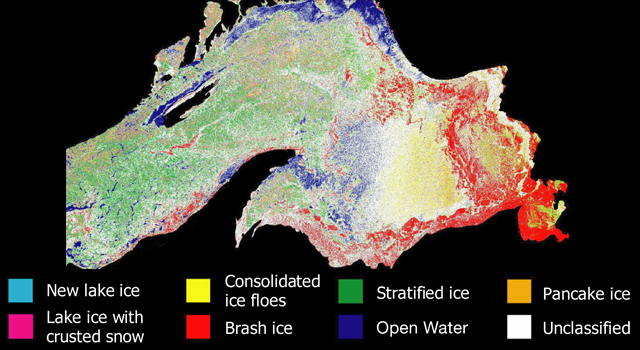Two scientists from NASA and NOAA have developed a new space-based technique for monitoring the ice cover of the Great Lakes that is so accurate it can identify a narrow channel of open water cut through the ice by an icebreaker -- even at night.
 A color-coded image of major ice types on Lake Superior, made from a RADARSAT1 radar backscatter image using a new NASA and NOAA-developed technique. Credit: NOAA Great Lakes Environmental Research Laboratory and NASA/JPL-Caltech
A color-coded image of major ice types on Lake Superior, made from a RADARSAT1 radar backscatter image using a new NASA and NOAA-developed technique. Credit: NOAA Great Lakes Environmental Research Laboratory and NASA/JPL-Caltech
"In the dark, it's difficult to read a map that's right in front of you," said Son Nghiem of NASA's Jet Propulsion Laboratory, Pasadena, Calif., one of the developers of the new technique. "Yet we now have a way to use satellite radars almost 500 miles [800 kilometers] out in space to see through clouds and darkness and map ice across the Great Lakes."
Ice on the Great Lakes puts a big chill on the U.S. and Canadian economies, affecting shipping, fishing and also public safety when winter and spring flooding are caused by ice jams. It has a significant impact on the regional environment and ecological systems as well. Yet previous techniques of analyzing satellite observations of the ice sometimes misidentified ice as water and vice versa.
The new method, co-developed by Nghiem and his colleague George Leshkevich of NOAA's Great Lakes Environmental Research Laboratory, Ann Arbor, Mich., not only corrects that problem, it also gives a more accurate analysis of ice characteristics, such as whether the ice is dense or full of bubbles, and whether it has melted and refrozen.
The method uses a special dictionary that translates binary digital data from satellite radar instruments on the Canadian Space Agency's RADARSAT-1/2, the European Space Agency's European Remote Sensing Satellite 2 (ERS-2), and Envisat to identify and map different types of ice over the Great Lakes. The researchers compiled the dictionary by pairing each observed ice type to a library of unique radar signatures that were measured on the lakes using a JPL-developed advanced radar aboard a U.S. Coast Guard icebreaking ship.
Leshkevich said the method has now been transitioned to NOAA for routine use in generating ice maps across the Great Lakes. "These maps will provide important information for environmental management, ice forecasting and modeling, off-shore wind farm development, operational icebreaking activities in support of winter navigation, and science research."
The more accurate classification of ice will also be useful for scientific research into such questions as how the Great Lakes are responding to, and leading, climate change in the upper Midwest.
Results of the study were published recently in the Journal of Great Lakes Research.
For more information, visit: http://www.iaglr.org/jglr/release/39/2013.05.003_leshkevich.php.